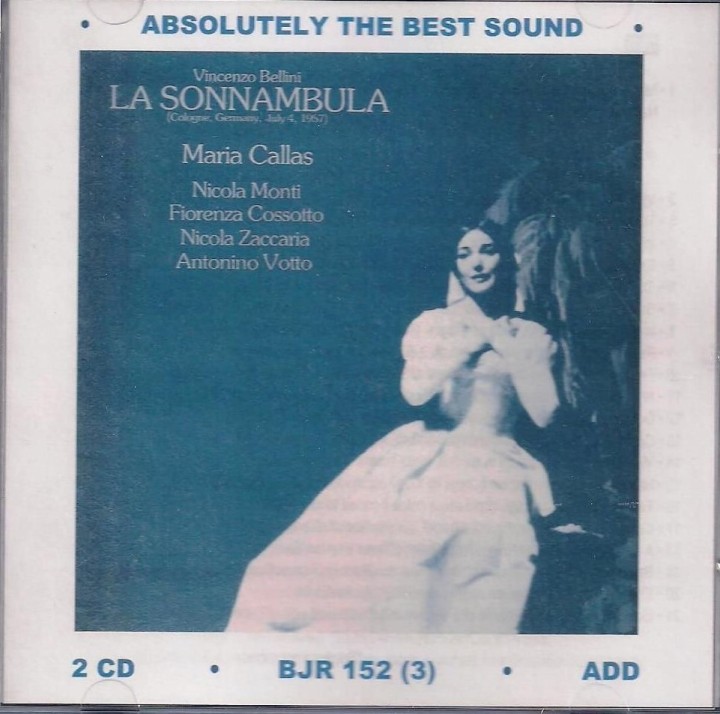
In March of 1957 La Scala revived the Visconti production of La Sonnambula preparatory to taking it on a short tour to Köln in July and the Edinburgh Festival in August. They had also made a studio recording of the opera in March with the same cast and conductor (Antonino Votto) as the La Scala stage performances. In Köln the acid-voiced Eugenia Ratti has been replaced by Marietta Angioletti and Alessio is now sung by Dino Mantovani, but otherwise the casts of the studio and Köln performances are identical, with Nicola Monti replacing Cesare Valletti as Elvino and Nicola Zaccaria replacing Giuseppe Modesti as Rodolfo from the original 1955 La Scala cast. Fiorenza Cossotto also took over the role of Teresa from Gabriela Carturan. Elsewhere on my site I have reviewed both the 1957 studio set and the 1955 Bernstein performance.
This Ars Vocalis issue is taken from BJR LPs and is probably a composite of the two performances she sang in Germany, as well as the dress rehearsal. That fact does not bother me unduly. After all, when major companies record live performances, they usually record more than one performance in order to come up with an acceptable release. The sound on this Ars Vocalis issue is actually rather good, almost as good as the studio recording and a good deal better than the 1955 Bernstein version.
The audience were clearly excited to have the great diva appearing in their city and her first notes are interrupted by a prolonged burst of applause, meaning she has to repeat them when the tumult has died down. We can’t see how she reacted but, vocally, she doesn’t step out of character for one second. Her voice in this performance has a pearly opalescence, which is perfectly apt for sweet, trusting Amina and her opening cavatina is beautifully shaped. In the cabaletta (Sovra il sen) she continues to keep the voice light and airy and adds a stunning top Eb at its close.
Much as I enjoy the 1955 Bernstein performance, this one possibly takes us closer to the Amina of Bellini’s and Romani’s dreams. Rarely has Callas’s voice sounded so lovely. Indeed the review of the performance in the Kölnische Rundschau talks of
the luminous beauty of the voice: melting sweetness in floating pianos, metallic brilliance in fortes, and in its coloratura, a perfect plasticity that one would only approximate very imprecisely with the usual comparisons from the instrumental realm.
The review also praises her acting, concluding that
the entire nineteenth-century operatic tradition is preserved herein a form that has become foreign to us, but that is, however, truly delightful.
Though some of Bernstein’s embellishments have now been trimmed away, she was obviously in superb voice and here repeats the stupendous cadenza inbetween the two verses of Ah non giunge, where she sweeps up to a fortissimo top Eb, on which she effects a stunning diminuendo before cascading down a perfect string-of pearls scale, a feat I’ve never heard equalled by any other soprano.
Nicola Monti is no Cesare Valletti, but he sounds a lot more confident in this live performance than he does on the studio recording and Zaccaria is a melifluous Rodolfo. Where Votto was a somewhat diffident conductor in the studio, here is he inspired by the live occasion and, given a choice between this and the studio performance, this is the one I would go for, especially in this excellent transfer.
2 thoughts on “Callas sings Amina in Köln, July 1957”